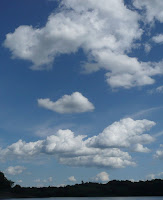 |
| #1650 "Cloud Signs" |
Where is the sun? That's an appropriate question to ask, especially during winter solstice. We need the sun for vitamin D and to lift our emotions. In real time, it is easy to find the sun most days. Just look up and you will find the bright orb in all except the darkest of overcast skies. But how to you find the sun in an image if the sun itself is not in the picture? Here are some Creative Scene Investigation tips.
You are in luck if there is a shadow in the scene. Simply follow the elongated shadow back to the source like a sun dial and you have your answer. After that it gets trickier.
A plein air artist typically paints with the sun on their back. There are several reasons for this. The sun feels good on your back especially on those cold and blustery days. Those same rays of warmth also illuminate the scene revealing the rich colours that might be there. The sun also lights up the canvas and the colours on the palette so that one can see the subtleties of the pigments. I tint every canvas with a colour that is complementary to the scene. That complementary tint also tones down the stark, bright whiteness of the canvas. The reflected glare off a white canvas can be as difficult and hard on your eyes as staring directly into the sun. A plein air artist rarely paints looking into the sun. If you see a back lit canvas from me, it is almost certain to be a studio work.If there are clouds in the image like in this example, you will also likely find your answer as to where the sun is hiding. How the cloud is illuminated reveals where the sun must be and the interpretation is really quite elementary.
 |
| Front lit Cumulus |
 |
| Back lit Cumulus |
I took these two cumulus cloud pictures seconds apart from my kayak. The sun does not have to be visible to deduce the direction of illumination or the wind. The wind direction was the same in both images. As a result, I was looking easterly to view the front lit clouds (above left) and westerly to photograph the back lit clouds (above right). If you apply Creative Scene Investigation (CSI) just to these images, you could deduce that the timing of the pictures had to be early to mid afternoon with a light northerly wind in advance of a ridge of high pressure.
This simple observation of cloud illumination clearly reveals the location of the sun. Most people probably realized this intuitively. The cloud shape also reveals the wind direction.
If you know any two of the following, you can easily deduce the third: sun position; time of day; direction of north. Given sunrise or sunset and with astronomical tables, the time of day and direction of view can be determined quite accurately.
I typically include a clue about the time of day and location in the title of my art - anything to make "Creative Scene Investigation" a bit easier and more accurate. I neglected to do both in painting number 1650 - sorry. I was painting in Rockport on the St Lawrence at 1:30 pm Saturday August 29th, 2015. Here is a link to this painting on Fine Art America where I describe the details behind this plein air work.
Keep you paddle in the water and warmest regards,
Phil the Forecaster Chadwick

No comments:
Post a Comment